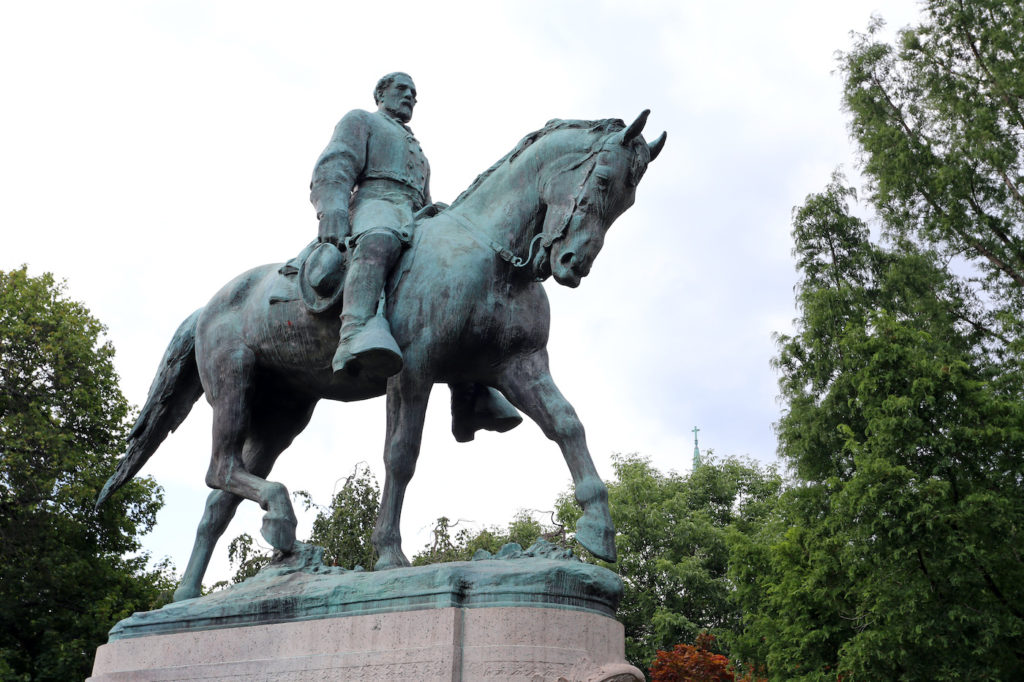J. Brandon Meeks’s recent reflection on Robert E. Lee and Southern memory in First Things is lovely, moving, and heartfelt, but it ultimately evades the real questions around public monuments. The questions that our country must grapple with are not about how a particular Southerner should remember his ancestors or even about the South more broadly.
That’s because public monuments are not fundamentally about recalling the past at all, whether privately or publicly. Rather, public monuments are forms of anamnesis—bringing the past into the present, to speak to the present. Through them, we look to the past not as mere memory but as guidance for the future. Monuments answer central questions about ourselves and our communities today—questions like “what should we honor in public?” This is another way of asking, “what kinds of communities do we want?”
Meeks originally wrote his piece after the city of Charlottesville removed an equestrian monument to Robert E. Lee that had presided over the town’s most prominent park since 1924. His essay is an incomplete account of Confederate memory in general, but it is an especially insufficient response to the particularities of the Charlottesville monument’s history.
Confederate monuments speak to the endurance of Southern separatism and Southern nationalism. The memorials erected in the decades immediately following the Civil War were also attempts to make sense of the unspeakable masses of the dead and maimed—and to offer some meaning to the countless numbers of widowed and fatherless Southerners. By 1924, most of the Civil War’s veterans and widows were dead, and the surviving orphans were elderly. Commemorating the passing generation certainly motivated the building of memorials, but the monuments also invoked the past in order to shape the future. Six decades after the war’s close, Charlottesville’s Lee statue was not meant to comfort those who grieved but, rather, to stoke the resentments of the aggrieved—to reassert the nobility of the Lost Cause, to ensure that the next generation would maintain the South’s defiant separatism, and to reaffirm the subjugation of the city’s black population.
Start your day with Public Discourse
Sign up and get our daily essays sent straight to your inbox.The Klan and the Monument
Questions of public honor and community formation animated the folks who put up the now infamous Charlottesville statues, including that of Lee, a century ago. The statues were erected just when, in the contemporaneous words of Charlottesville’s newspaper, The Daily Progress,
a legion of white robed Virginians . . . renewed the faith of their fathers. Which is by way of saying that the Ku Klux Klan has been organized in this city. Hundreds of Charlottesville’s leading business and professional men met around the tomb of Jefferson at the midnight hour one night last week and sealed the pledge of chivalry and patriotism with the deepest crimson of red American blood.
The unveiling of the monument was accompanied by a week of celebration, the climax of which was a grand parade by the Ku Klux Klan. The Daily Progress reported that “thousands lined the sidewalks of Main Street” to witness the nighttime “march of the white robed figures.” The march culminated at “the foot of Vinegar Hill,” which was then (and continued to be, until its seizure by the city in 1964 and subsequent demolition) the city’s largest black neighborhood.
What should we honor in public? What kinds of communities do we want?
Those white-robed Klansmen had clear answers to these questions. And, despite the obscurantism of some Confederate-monument defenders, these answers are not hidden by the sands of time. They are knowable and known. They had nothing to do with “an abstract history of conflicting ideas,” as Meeks puts it. They were concerned with the reassertion of power and the threat of violence.
Those same questions and those same concerns animated the “alt-right” mob that upended Charlottesville on August 12, 2017, soiling the city’s reputation for leisurely Southern charm and picturesque history, and destroying my own confidence in the pastness of the American past in the process. When they marched through the town with torches, chanting “Jews will not replace us,” the members of that mob were not thinking about the yellowing portraits that line the hallways of Southern homes.
What concerns us, in turn, are not private thoughts lurking in the dark corners of minds but rather the public purposes of these monuments. Our question should be whether and how their erection and ongoing presence served the purposes of the Klan and of Jim Crow, including racial subjugation and the maintenance of Southern nationalism.
Public monuments are not mere memory. We do not place our cautionary tales on literal pedestals. We memorialize for the purpose of public imitation.
Lee and His Statue
Robert E. Lee was unquestionably a great man by the standards of his day. And although Lee’s support for a wicked cause, his profitable exploitation of and trade in human flesh, and his own purported brutality as a slave owner complicate this portrait of greatness, to put it mildly, his vices do not eliminate his virtues. These include his love of home and family, his noteworthy public humility, and his quiet but unshakable piety. If we were merely asking how we should remember Lee and other Southerners, Meeks’s reflections would be compelling, if incomplete.
Public monuments, however, are not mere memory. Nor do we cast a man in bronze, posed nobly on horseback in the town center, so that we might confront our shared human potential for evil. We do not place our cautionary tales on literal pedestals.
We memorialize for the purpose of public imitation.
Those who put up the Lee statue a century ago surely did want to memorialize Lee’s “chivalry and patriotism”—a paradoxical patriotism expressed by raising his sword for his state and against his country. Still, there were many other chivalrous patriots they might have turned to for a public monument. It was in fact the most wicked elements of Lee’s biography that they were putting up for emulation.
When I think of the Lee statue, I do not think of the man himself—dead a half-century before the statue was erected—nor of my own Southern ancestors, nor of abstract ideas. I think of the white-robed Virginians who rebirthed the Klan as the statues went up around the city. I think of lynchings. I think of “massive resistance,” when in 1958 Charlottesville’s leading men once again renewed the faith of their fathers, this time by moving the public school to a historic parish church less than a quarter mile from Lee Park in order to contravene federal law and maintain segregation. I think of bulldozed neighborhoods. I think of the frightened black family I encountered the night before the Charlottesville riot. And I think of Heather Heyer, run down to keep Lee and Traveller up on their pedestal.
I appreciate Meeks’s desire for a more nuanced public discussion, for a conversation that embraces neither yesterday’s hagiographies nor today’s Two Minutes Hate. But the Lee statue was never an invitation to reflect on the mysterious glories and depravities of the human person. It was a proclamation and a prescription. It proclaimed the enduring nobility of the Lost Cause, and it prescribed the maintenance and reassertion of herrenvolk democracy in 1920s Charlottesville, amid the unprecedented national popularity of black culture, a newly assertive sense of black identity, the ongoing Great Migration, and the destabilizing aftermath of the Great War.
We should expect discontinuities in a statue’s public meaning over the course of a century. Nevertheless, monuments are not naked ciphers whose meaning resides only in private thought and individual feeling. They are public, and their public purposes did not simply evaporate with the passage of time. Nor should we delude ourselves into thinking that those purposes disappeared with the end of the legal Jim Crow system during the civil rights movement. The neo-Confederates, neo-Nazis, and assorted other white nationalists who rallied to the Lee statue’s defense in 2017 surely should have disabused us of such magical thinking.
The Lee statue was never an invitation to reflect on the mysterious glories and depravities of the human person. It was a proclamation and a prescription.
Monuments and Memory, History and Heritage
Counterintuitively, debate about public monuments has relatively little to do with remembering our forebears, and nothing at all to do with the murky recesses of Southern hearts. Removing the Lee statue is not about repudiating the beliefs of long-dead Klansmen, nor is it an exercise in policing the interior life of contemporary Southerners.
Monuments answer questions about which parts of our history we choose to make into a public heritage—which strands of the past we choose to bring into the present in order to shape and form the future. Thus, taking down monuments is not a choice to forget the past. It is a choice not to honor certain elements of our past in public. Removing Charlottesville’s Lee statue from its place of high honor seeks to excise the Klan from our heritage—to say that we will not be a community formed by and oriented toward the public message originally intended and enduringly conveyed by the statues of Jim Crow.
Being honest with ourselves about the origins and ongoing purposes of Confederate monuments does not require us to demonize the past, nor should this honesty about the past make us blind to the present. Unquestionably, the impulses that brought down the monuments in Charlottesville were destructive rather than constructive. Whatever the city manages to put up on those empty pedestals is likely to be ugly or vapid at best.
Monuments answer questions about which parts of our history we choose to make into a public heritage—which strands of the past we choose to bring into the present in order to shape and form the future.
But these are distinct questions. The fact that some want to destroy the good with the bad does not mean we must uphold wickedness in our defense of goodness. More to the point, casting our lot with the legacy of the Klan will do us no good as we seek to uphold truth and beauty amid the devastations of late modernity.
What should we honor in public? What kinds of communities do we want?
Putting up Lee’s statue in the heart of Charlottesville a century ago provided one answer. We should reject that answer.













